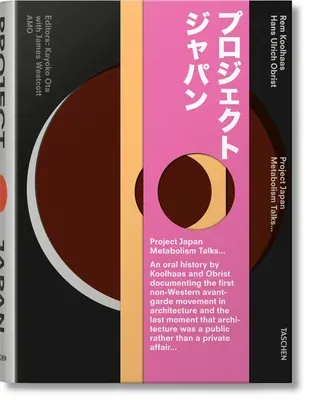"Once there was a nation that went to war, but after they conquered a
continent their own country was destroyed by atom bombs... then the
victors imposed democracy on the vanquished. For a group of apprentice
architects, artists, and designers, led by a visionary, the dire
situation of their country was not an obstacle but an inspiration to
plan and think... although they were very different characters, the
architects worked closely together to realize their dreams, staunchly
supported by a super-creative bureaucracy and an activist state... after
15 years of incubation, they surprised the world with a new
architecture--Metabolism--that proposed a radical makeover of the entire
land... Then newspapers, magazines, and TV turned the architects into
heroes: thinkers and doers, thoroughly modern men... Through sheer hard
work, discipline, and the integration of all forms of creativity, their
country, Japan, became a shining example... when the oil crisis
initiated the end of the West, the architects of Japan spread out over
the world to define the contours of a post-Western aesthetic...." --Rem
Koolhaas / Hans Ulrich Obrist
Between 2005 and 2011, architect Rem Koolhaas and curator Hans Ulrich
Obrist interviewed the surviving members of Metabolism--the first
non-Western avant-garde, launched in Tokyo in 1960, in the midst of
Japan's postwar miracle. Project Japan features hundreds of
never-before-seen images--master plans from Manchuria to Tokyo, intimate
snapshots of the Metabolists at work and play, architectural models,
magazine excerpts, and astonishing sci-fi urban visions--telling the
20th-century history of Japan through its architecture.
From the tabula rasa of a colonized Manchuria in the 1930s, a devastated
Japan after the war, and the establishment of Metabolism at the 1960
World Design Conference in Tokyo to the rise of Kisho Kurokawa as the
first celebrity architect, the apotheosis of Metabolism at Expo '70 in
Osaka, and its expansion into the Middle East and Africa in the 1970s:
The result is a vivid documentary of the last moment when architecture
was a public rather than a private affair. Oral history by Rem Koolhaas
and Hans Ulrich Obrist
Extensive interviews with Arata Isozaki, Toshiko Kato, Kiyonori
Kikutake, Noboru Kawazoe, Fumihiko Maki, Kisho Kurokawa, Kenji Ekuan,
Atsushi Shimokobe, and Takako and Noritaka Tange
Hundreds of never-before-seen images, architectural models, and magazine
excerpts
Layout by award-winning Dutch designer Irma Boom
Further reading

